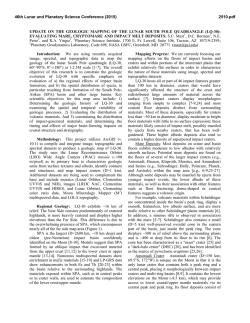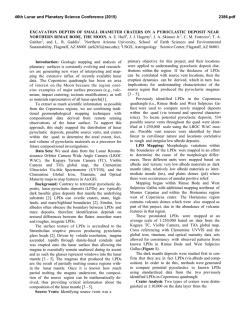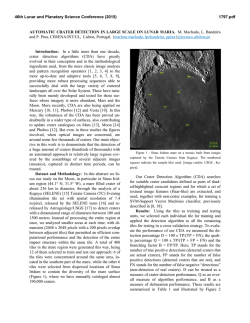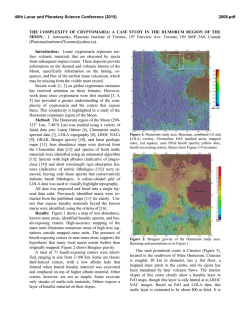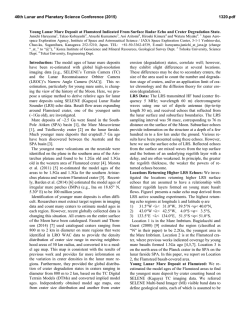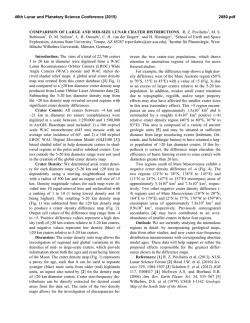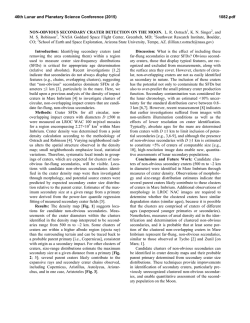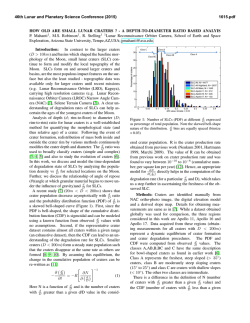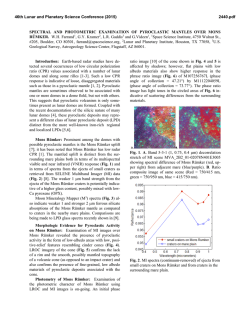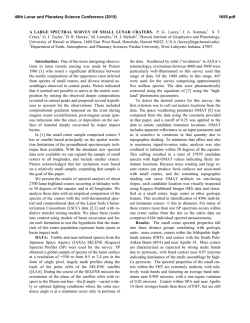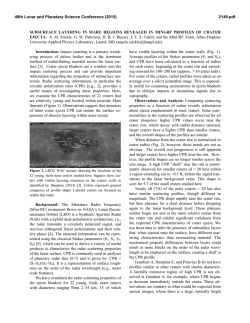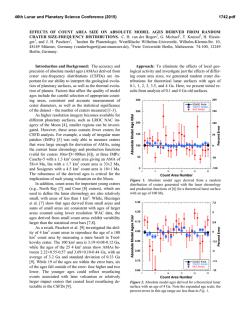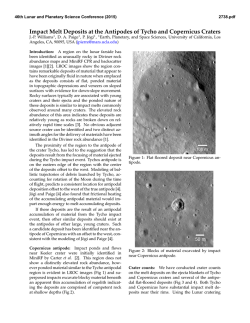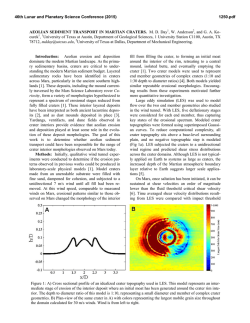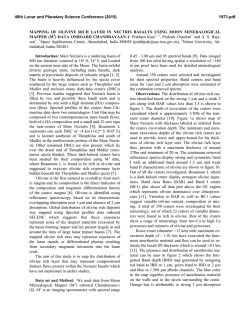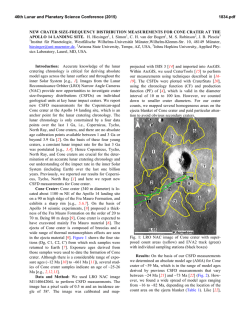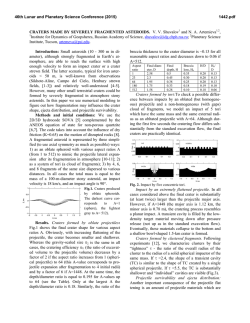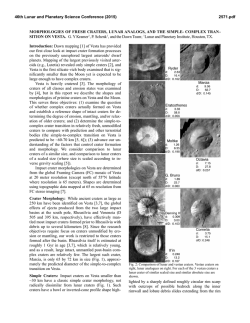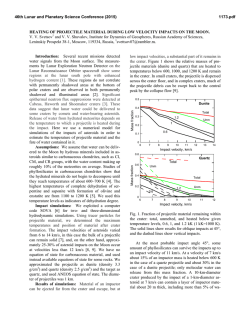
PYROCLASTIC VOLCANISM WITHIN LUNAR FLOOR
46th Lunar and Planetary Science Conference (2015) 1354.pdf PYROCLASTIC VOLCANISM WITHIN LUNAR FLOOR-FRACTURED CRATERS. Rebecca. J. Thomas1, David A. Rothery1, Susan J. Conway1 and Mahesh Anand1,2, 1Dept. of Physical Sciences, The Open University, Milton Keynes, MK7 6AA, U.K. ([email protected]), 2Dept. of Earth Sciences, The Natural History Museum, London, SW7 5BD, U.K. Introduction: It has long been recognized that localized lunar pyroclastic deposits (LPDs) preferentially occur within impact craters, frequently along circumferential fractures in floor-fractured craters (FFCs) [1,2]. It has been proposed that both floor-fracturing and crater-centered volcanism occur when ascending magma is arrested in the low-density zone beneath the impact crater [1]. A sill forms, which, on reaching the width of the brecciated zone, inflates to form a laccolith. Fractures propagate from the intrusion margins to the surface, favoring magma ascent and effusive and/or explosive volcanism [3,4]. However, in light of evidence that subcrater magma storage also occurs on the planet Mercury but does not lead to floor-fracturing [5,6], it is necessary to reassess the conditions that lead to this specific morphology on the Moon. One possible explanation is that on the Moon higher magmatic driving pressure enabled penetration of magmas to shallower depths within the subcrater brecciated zone, resulting in more surface deformation. A mechanism that could produce this enhanced driving pressure has previously been proposed: that the magma forming intrusions was in hydrostatic equilibrium with coeval large-scale mare lavas in adjacent basins [1]. In order to test whether this model is sufficient to explain the occurrence of LPDs and floor-fracturing within impact craters on the Moon, we have studied 15 lunar complex craters hosting localized dark mantling deposits indicative of pyroclastic volcanism, plus 23 FFCs where no pyroclastic deposits are observed. Through analysis of the geological context of each crater, we have determined whether its stratigraphic and geographical position indicates that the pyroclastic activity and/or floor-fracturing was associated with contemporaneous emplacement of mare lavas at a similar elevation. We find that this is not always the case, and that in some cases the formation of such shallow intrusions may have been favored by alternative controls, such as an extensional regional stress regime. Site selection: We selected 15 LPD-hosting impact craters from previously-identified [7,8] sites where the presence of pyroclastic deposits is relatively uncontroversial. We also selected 23 FFCs catalogued by [9] where no pyroclastic or effusive deposits appear to be associated with the floor-fractures. In both sample sets, only complex craters (30–140 km diameter [10]) were selected so that subsurface crater- related structures could be considered broadly comparable across the sample set. We investigated the geological context of these craters through examination of the 100 m/pixel LROCWAC global mosaic [11] and geologic maps produced by the U.S. Geological Survey. Using elevation values from the LRO LOLA global 118 m/pixel DEM [12], we calculated crater depth as the difference between the mean elevation of the rim crest and the most frequent elevation (in 100 m bins) within the crater interior. We compared this value with the median elevation value of large (> 1000 km2) samples of the nearest mare deposits not superposed by the crater. Comparison of LPD-hosting craters and nonLPD-hosting FFCs: All but one of the craters hosting an LPD had previously been identified as an FFC [8]. The anomalously shallow, fragmented floor of the remaining example, Hell, suggest that this may also be an FFC. To determine whether FFCs hosting and not hosting LPDs are quantitatively different, we used the approach outlined in [4] to model the magma drivingpressure necessary to produce the FFC and the flexural thickness (Te) of the overburden. We found that magma driving-pressures span a similar range in both sample sets. In both samples, Te scales with crater diameter (R2=0.86), and this trend is not statisticallyseperable between the two samples (Fig. 1). Thus, it does not appear that the depth or magmatic driving pressure is significantly different for intrusions with and without associated pyroclastic eruptions. Fig. 1. Modelled flexural thickness of the overburden in LPD and non-LPD-hosting FFCs of a similar size is not statistically discriminable (lines: linear fit, greyed regions: 95% confidence interval). Relationship of craters with extensive mare deposits: In many cases in both sample sets, the crater is adjacent to an extensive mare deposit and its floor is 0 - 500 m above the elevation of the mare surface. In these cases the existing model, where FFCs form when 46th Lunar and Planetary Science Conference (2015) magma stalls beneath impact craters at the level of nearby coeval mare deposits, may be appropriate. However, this hypothesis makes two major assumptions: that the effusive and explosive volcanic activity were coeval and that their magmatic plumbing was connected. We observe two types of sites where these assumptions are untenable: 1. Craters that superpose (and so post-date) a surrounding extensive mare deposit and have floor elevations significantly lower than any nearby mare surface (Fig. 2). This implies that, even if further mare infilling of the surrounding basin occurred after emplacement of the part superposed by the impact crater, hydrostatic pressure should favor mare flooding of the crater rather than formation of a sub-crater intrusion. 2. Craters remote (> 250 km) from extensive mare deposits, with a floor elevation lower than the nearest such deposits (Fig. 3). 1354.pdf intrusions are favored. Modelling suggests that loading by basin-filling mare deposits places the region in a broad annulus around major lunar basins in a state of extension [14]. As many of the ‘anomalous’ examples in our samples fall within this zone, this stress regime may account, at least in part, for the formation of FFCs at such locations. Fig. 3. While the LPD-hosting FFC Alphonsus lies adjacent to lavas that are at a slightly lower elevation than its floor, another LPD-hosting crater, Airy (5.8° E, 18.1° S) is > 360 km distant from the lavas and has a lower floor elevation (Imbrian-aged mare samples: blue, Eratosthenian: purple). Fig. 2. The FFC Cardanus (-72.6° E, 13.3° N) lies at the outer margin of Oceanus Procellarum, superposing the mare fill. The closest (Eratosthenian aged) mare deposit that may post-date it (sample in purple) is at a considerably higher elevation. In these cases an alternative explanation is necessary for the formation of intrusions shallow enough to fracture the crater’s floor, particularly in light of the absence of floor-fracturing when magma becomes localized beneath impact craters on Mercury [6]. Along with driving pressure, the main control on the depth at which intrusions form is the regional horizontal stress regime [13]. Where there is compression, as on Mercury, deeper magma storage is favored, whereas in extensional regimes, shallower References: [1] Head, J.W. and Wilson, L. (1979) Lunar Planet. Sci. Conf. Proc., 10, 2861–2897. [2] Coombs, C.R. and Hawke, B.R. (1992) Proc. Lunar Planet. Sci., 22, 303-312. [3] Schultz, P.H. (1976) Moon, 15, 241-273. [4] Jozwiak, L.M. et al. (2015) Icarus, 248, 424-447. [5] Thomas, R.J. et al. (2014) J. Geophys. Res. Planets, 119, 2239-2254. [6] Thomas, R.J. et al. (2015), LPSC 46, this volume. [7] Gaddis, L.R. et al. (2003) Icarus, 161(2), 262-280. [8] Gustafson, J.O. (2012) J. Geophys. Res. Planets, 117(E12). [9] Jozwiak, L.M. et al. (2012) J. Geophsy. Res., 117(E11). [10] Pike, R.J. (1980) US Geol. Soc. Prof. Pap. 1046 -C, C1–C77. [11] LROC Team (2014), ASU. [12] LOLA Science Team (2014), Goddard Space Flight Center. [13] Menand, T. (2011) Tectonophysics, 500(1-4), 11–19. [14] McGovern, P. J. et al. (2014) Lunar Planet. Sci. Conf., 45, 2771.
© Copyright 2025
